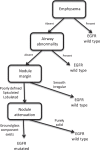Predictive radiogenomics modeling of EGFR mutation status in lung cancer
- PMID: 28139704
- PMCID: PMC5282551
- DOI: 10.1038/srep41674
Predictive radiogenomics modeling of EGFR mutation status in lung cancer
Abstract
Molecular analysis of the mutation status for EGFR and KRAS are now routine in the management of non-small cell lung cancer. Radiogenomics, the linking of medical images with the genomic properties of human tumors, provides exciting opportunities for non-invasive diagnostics and prognostics. We investigated whether EGFR and KRAS mutation status can be predicted using imaging data. To accomplish this, we studied 186 cases of NSCLC with preoperative thin-slice CT scans. A thoracic radiologist annotated 89 semantic image features of each patient's tumor. Next, we built a decision tree to predict the presence of EGFR and KRAS mutations. We found a statistically significant model for predicting EGFR but not for KRAS mutations. The test set area under the ROC curve for predicting EGFR mutation status was 0.89. The final decision tree used four variables: emphysema, airway abnormality, the percentage of ground glass component and the type of tumor margin. The presence of either of the first two features predicts a wild type status for EGFR while the presence of any ground glass component indicates EGFR mutations. These results show the potential of quantitative imaging to predict molecular properties in a non-invasive manner, as CT imaging is more readily available than biopsies.
Conflict of interest statement
The authors declare no competing financial interests.
Figures



References
-
- Siegelin M. D. & Borczuk A. C.. Epidermal growth factor receptor mutations in lung adenocarcinoma. Lab6oratory investigation; a journal of technical methods and pathology 94, 129–137 (2014). - PubMed
-
- Riely G. J., Marks J. & Pao W.. KRAS mutations in non-small cell lung cancer. Proceedings of the American Thoracic Society 6, 201–205 (2009). - PubMed
Publication types
MeSH terms
Substances
Grants and funding
LinkOut - more resources
Full Text Sources
Other Literature Sources
Medical
Research Materials
Miscellaneous

